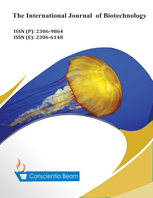Effect of Different Extraction Solvents on the Antimicrobial Activity of Psidium Guajava (Guava) Leaves against Multi-Drug Resistant Bacteria Implicated in Nosocomial Infections
DOI:
https://doi.org/10.18488/journal.57.2020.91.24.37Abstract
This present work was designed to investigate the effect of different extraction solvents on the antimicrobial activity of Psidium guajava leaves against some multidrug resistant bacteria in nosocomial infections. The MDR isolates such as Pseudomonas aeruginosa, Escherichia coli, Staphylococcus epidermidis, Proteus mirabilis, Staphylococcus saprophyticus and Bacillus cereus were obtained from Microbiology department culture collection of Department of Microbiology University of Ibadan Nigeria and their identities reconfirmed using biochemical methods. The antimicrobial activities of the different solvent extracts were tested using agar well diffusion method while the minimum inhibitory concentration (MIC) and the minimum bactericidal concentration (MBC) of the extracts were monitored using the double fold dilution method. The results reconfirmed the identities of the bacteria as Pseudomonas aeruginosa, Escherichia coli, Staphylococcus epidermidis, Proteus mirabilis, Staphylococcus saprophyticus and Bacillus cereus. Methanol extracts at a concentration of 160 mg/ml showed the highest inhibition zone of 10.0±0.1mm followed by ethyl acetate extract with 8.0±0.6mm inhibition zone against E.coli which were significantly different (P<0.05) while N-hexane, cold and hot water showed zero inhibition zones. Ofloxacin and DMSO. showed 20.0±0.and 0.00 mm inhibition zones respectively. This trend was observed at all the other concentrations. Methanol and ethyl acetate had MIC of 40.0 mg/ml for E. coli, S. saprophyticus, P.aeruginosa and B. cereus and they showed MBC of 80.0mg/ml for E. coli, S. saprophyticus, P.aeruginosa and B. cereus and MBC of 40.0 mg/ml for S. Epidermidis. Methanol and ethyl acetate extracts could be employed in the treatment of bacterial infections caused by MDR bacteria.

